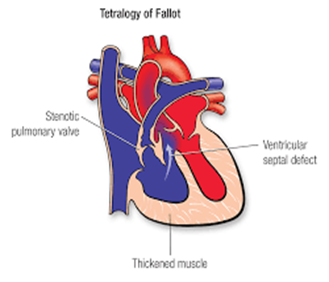The Foley Family is caring for their youngest child, Justin, who is suffering from tetralogy of Fallot. Which of the following are defects associated with this congenital heart condition?
Coarctation of aorta, aortic valve stenosis, mitral valve stenosis, and patent ductus arteriosus
Ventricular septal defect, overriding aorta, pulmonic stenosis (PS), and right ventricular hypertrophy
Aorta exits from the right ventricle, pulmonary artery exits from the left ventricle, and two noncommunicating circulations
Tricuspid valve atresia, atrial septal defect, ventricular septal defect, and hypoplastic right ventricle
The Correct Answer is B
Tetralogy of Fallot is a congenital heart defect characterized by four specific abnormalities:
Ventricular septal defect (VSD): This is a hole in the wall (septum) between the two lower chambers (ventricles) of the heart.
Overriding aorta: The aorta is positioned over both the left and right ventricles, which allows oxygen-poor (deoxygenated) blood from the right ventricle to be pumped into the aorta and to the body.
Pulmonic stenosis (PS): This is a narrowing of the pulmonary valve or artery that restricts blood flow from the right ventricle to the lungs.
Right ventricular hypertrophy: The right ventricle becomes thicker and more muscular as it works harder to pump blood against the narrowed pulmonary valve or artery.
Options A, C, and D describe different congenital heart conditions and defects, but they are not associated with Tetralogy of Fallot:
A. Coarctation of aorta, aortic valve stenosis, mitral valve stenosis, and patent ductus arteriosus are not part of the constellation of defects seen in the Tetralogy of Fallot.
C. Describing the aorta exiting from the right ventricle and pulmonary artery exiting from the left ventricle with two noncommunicating circulations is characteristic of transposition of the great arteries, not Tetralogy of Fallot.
D. Tricuspid valve atresia, atrial septal defect, ventricular septal defect, and hypoplastic right ventricle describe a different congenital heart condition, not Tetralogy of Fallot.

Nursing Test Bank
Naxlex Comprehensive Predictor Exams
Related Questions
Correct Answer is ["C"]
Explanation
After a cardiac catheterization procedure, it is essential to restrict activity and keep the affected extremity immobilized to prevent complications such as bleeding and hematoma formation at the catheter insertion site. Encouraging play and activity can increase the risk of disrupting the catheter site or causing bleeding.
The other interventions are generally appropriate after a cardiac catheterization procedure:
A. Putting pressure above the catheter site for first signs of bleeding: This is a standard procedure to monitor for any bleeding at the catheter site and is an appropriate intervention.
B. Regularly check the pulses and temperature of the affected extremity: Monitoring pulses and temperature is important to assess for adequate circulation and early detection of any vascular complications.
D. Encouraging the parents to ambulate with the child 3 hours, or the soonest possible time, after the procedure to prevent blood clots: Early mobilization can help prevent blood clots, and it is generally a recommended intervention following cardiac catheterization.
E. Monitor cardiac function and oxygen saturation: Continuous monitoring of cardiac function and oxygen saturation is crucial to detect any immediate post-procedure complications and ensure the child's cardiovascular stability.
Correct Answer is C
Explanation
The presence of leukocytes, nitrates, and blood in the urine, along with a urinary pH of 6.5, is suggestive of a urinary tract infection (UTI). Additionally, symptoms such as frequent urination, pain or discomfort during urination, or other urinary symptoms may also be present in UTIs.
The other options (A, B, and D) are less likely based on the provided information:
A. Nephrotic syndrome typically presents with significant proteinuria and edema but may not show the specific findings seen in a UTI urinalysis.
B. Acute glomerulonephritis may have different urinalysis findings, including hematuria and proteinuria, but the presence of nitrates and leukocytes in the urine is not a typical feature.
D. Diabetes mellitus Type 1 may have glucose in the urine, but the presence of nitrates, leukocytes, and blood in the urine is more indicative of a UTI than diabetes.
Whether you are a student looking to ace your exams or a practicing nurse seeking to enhance your expertise , our nursing education contents will empower you with the confidence and competence to make a difference in the lives of patients and become a respected leader in the healthcare field.
Visit Naxlex, invest in your future and unlock endless possibilities with our unparalleled nursing education contents today
Report Wrong Answer on the Current Question
Do you disagree with the answer? If yes, what is your expected answer? Explain.
Kindly be descriptive with the issue you are facing.
